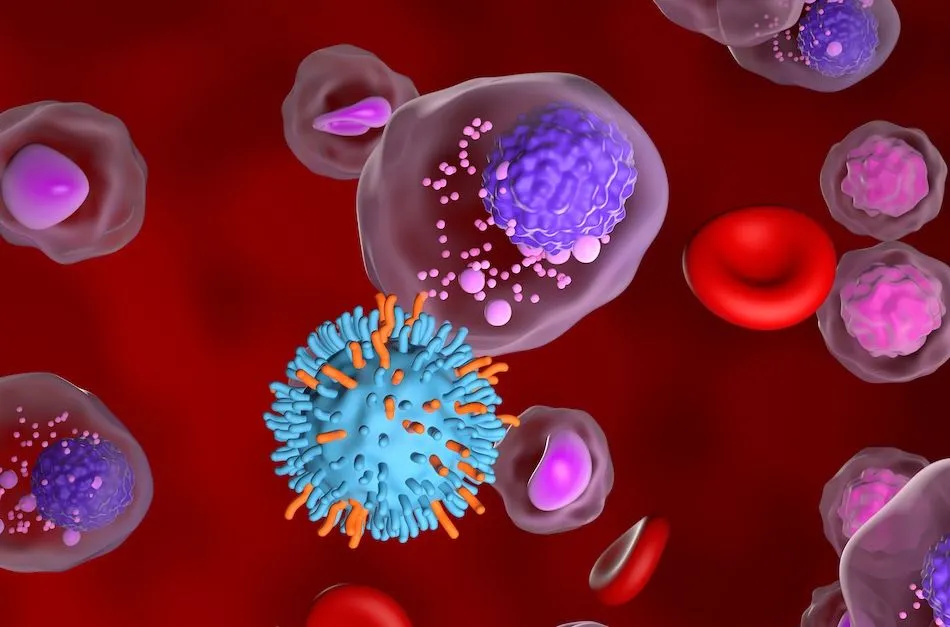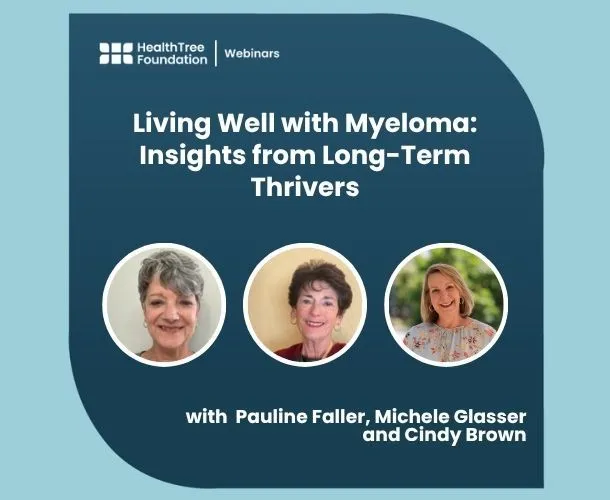HealthTree University: Multiple Myeloma Basics Part 1 (3 of 3)

Myeloma can be complicated! It’s not staged like other cancers. How do you know if your myeloma is even considered active cancer? It can be inside or outside of the bone marrow, and it can express itself in different ways in different parts of the body. Thankfully, our myeloma expert faculty are here to help break down all these topics to be simple enough for everyone to understand. Below are some video excerpts from our HealthTree University curriculum.
If you register in HealthTree to use HealthTree University, you can save and keep track of your progress, get points for answering quiz questions, bookmark videos, take notes, earn prizes [COMING SOON], and get access to all the other features of HealthTree.
1.11 - How do I know the stage of my myeloma?
Myeloma isn’t staged like Breast or Lung cancer. This makes it hard to know how “high-risk” you are! There are criteria called the Revised Multiple Myeloma International Staging System (R-ISS) which Dr. Qazilbash breaks down in this video:
Featuring:
- Muzaffar Qazilbash, MD of MD Anderson Cancer Center
1.12 - How is active myeloma defined?
How is active myeloma defined? Myeloma defining events, which are also called CRAB symptoms, where the acronym CRAB stands for Calcium, Renal, Anemia, Bone lesions, are used to determine if a patient has active myeloma. CRAB symptoms and other criteria diagnosed by a doctor will determine if symptomatic myeloma requires clinical treatment.
When patients initially present with a plasma cell disorder, we have to characterize whether or not someone has a precursor condition such as MGUS or smoldering myeloma or whether or not they have a systemic myeloma that requires treatment. The actual level of M protein that defines myeloma technically speaking is 3 grams per deciliter.
Featuring:
- Muzaffar Qazilbash, MD of MD Anderson Cancer Center
- Alexander Lesokhin, MD of Memorial Sloan Kettering Cancer Center
1.13 - What is extramedullary disease?
Myeloma doesn’t always stay inside the bone marrow, and can move around and cause problems where it usually doesn’t.
Featuring:
- Amrita Krishan, MD of City of Hope
1.14 - What is a plasmacytoma?
Myeloma cells can aggregate into a ball, inside the bone or outside of the bone. Usually, it’s not as bad as that sounds.
Featuring:
- Philip McCarthy, MD of Roswell Park Comprehensive Cancer Center
- Keith Stockerl-Goldstein, MD of Washington University in St. Louis
1.15 - What is plasma cell leukemia?
Sometimes myeloma cells circulate in the bone marrow.
Featuring:
- Philip McCarthy, MD of Roswell Park Comprehensive Cancer Center
- Craig Hofmeister, MD, MPH of Winship Cancer Institute of Emory University
1.16 - Primary PCL (plasma cell leukemia) vs. secondary PCL
Primary = treatable if treated aggressively with treatment. Secondary = usually in more advanced patients and is harder to treat.
Featuring:
- Philip McCarthy, MD of Roswell Park Comprehensive Cancer Center
Want more?
We have over 200 HealthTree University videos online at university.healthtree.org! Learn the basics (and the not-so-basics) of myeloma from some of the top myeloma doctors in the world!
Other HealthTree University Classes:
- Myeloma Basics Part 1
- Myeloma Basics Part 2
- Myeloma Basics Part 3
- Building Your HealthCare Team
- Becoming an Empowered Patient
- Starting Myeloma Treatment
- Autologous Stem Cell Transplant (ASCT)
- Precursor Conditions
- Relapsed and Refractory MM Treatment
- Myeloma Bone Disease
- Testing, Monitoring MM Markers
- [BETA] Multiple Myeloma Genetics and Precision Medicine
- Classes of Myeloma Drugs
- [BETA] COVID-19 and Multiple Myeloma
Myeloma can be complicated! It’s not staged like other cancers. How do you know if your myeloma is even considered active cancer? It can be inside or outside of the bone marrow, and it can express itself in different ways in different parts of the body. Thankfully, our myeloma expert faculty are here to help break down all these topics to be simple enough for everyone to understand. Below are some video excerpts from our HealthTree University curriculum.
If you register in HealthTree to use HealthTree University, you can save and keep track of your progress, get points for answering quiz questions, bookmark videos, take notes, earn prizes [COMING SOON], and get access to all the other features of HealthTree.
1.11 - How do I know the stage of my myeloma?
Myeloma isn’t staged like Breast or Lung cancer. This makes it hard to know how “high-risk” you are! There are criteria called the Revised Multiple Myeloma International Staging System (R-ISS) which Dr. Qazilbash breaks down in this video:
Featuring:
- Muzaffar Qazilbash, MD of MD Anderson Cancer Center
1.12 - How is active myeloma defined?
How is active myeloma defined? Myeloma defining events, which are also called CRAB symptoms, where the acronym CRAB stands for Calcium, Renal, Anemia, Bone lesions, are used to determine if a patient has active myeloma. CRAB symptoms and other criteria diagnosed by a doctor will determine if symptomatic myeloma requires clinical treatment.
When patients initially present with a plasma cell disorder, we have to characterize whether or not someone has a precursor condition such as MGUS or smoldering myeloma or whether or not they have a systemic myeloma that requires treatment. The actual level of M protein that defines myeloma technically speaking is 3 grams per deciliter.
Featuring:
- Muzaffar Qazilbash, MD of MD Anderson Cancer Center
- Alexander Lesokhin, MD of Memorial Sloan Kettering Cancer Center
1.13 - What is extramedullary disease?
Myeloma doesn’t always stay inside the bone marrow, and can move around and cause problems where it usually doesn’t.
Featuring:
- Amrita Krishan, MD of City of Hope
1.14 - What is a plasmacytoma?
Myeloma cells can aggregate into a ball, inside the bone or outside of the bone. Usually, it’s not as bad as that sounds.
Featuring:
- Philip McCarthy, MD of Roswell Park Comprehensive Cancer Center
- Keith Stockerl-Goldstein, MD of Washington University in St. Louis
1.15 - What is plasma cell leukemia?
Sometimes myeloma cells circulate in the bone marrow.
Featuring:
- Philip McCarthy, MD of Roswell Park Comprehensive Cancer Center
- Craig Hofmeister, MD, MPH of Winship Cancer Institute of Emory University
1.16 - Primary PCL (plasma cell leukemia) vs. secondary PCL
Primary = treatable if treated aggressively with treatment. Secondary = usually in more advanced patients and is harder to treat.
Featuring:
- Philip McCarthy, MD of Roswell Park Comprehensive Cancer Center
Want more?
We have over 200 HealthTree University videos online at university.healthtree.org! Learn the basics (and the not-so-basics) of myeloma from some of the top myeloma doctors in the world!
Other HealthTree University Classes:
- Myeloma Basics Part 1
- Myeloma Basics Part 2
- Myeloma Basics Part 3
- Building Your HealthCare Team
- Becoming an Empowered Patient
- Starting Myeloma Treatment
- Autologous Stem Cell Transplant (ASCT)
- Precursor Conditions
- Relapsed and Refractory MM Treatment
- Myeloma Bone Disease
- Testing, Monitoring MM Markers
- [BETA] Multiple Myeloma Genetics and Precision Medicine
- Classes of Myeloma Drugs
- [BETA] COVID-19 and Multiple Myeloma
about the author
Jennifer Ahlstrom
Myeloma survivor, patient advocate, wife, mom of 6. Believer that patients can contribute to cures by joining HealthTree Cure Hub and joining clinical research. Founder and CEO of HealthTree Foundation.
More on HealthTree Programs
Trending Articles




Get the Latest Multiple Myeloma Updates, Delivered to You.
By subscribing to the HealthTree newsletter, you'll receive the latest research, treatment updates, and expert insights to help you navigate your health.
Together we care.
Together we cure.
3x Faster.













